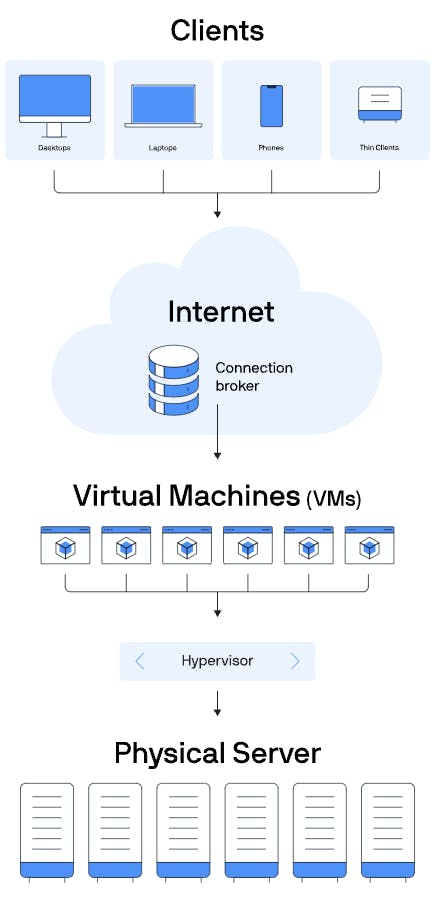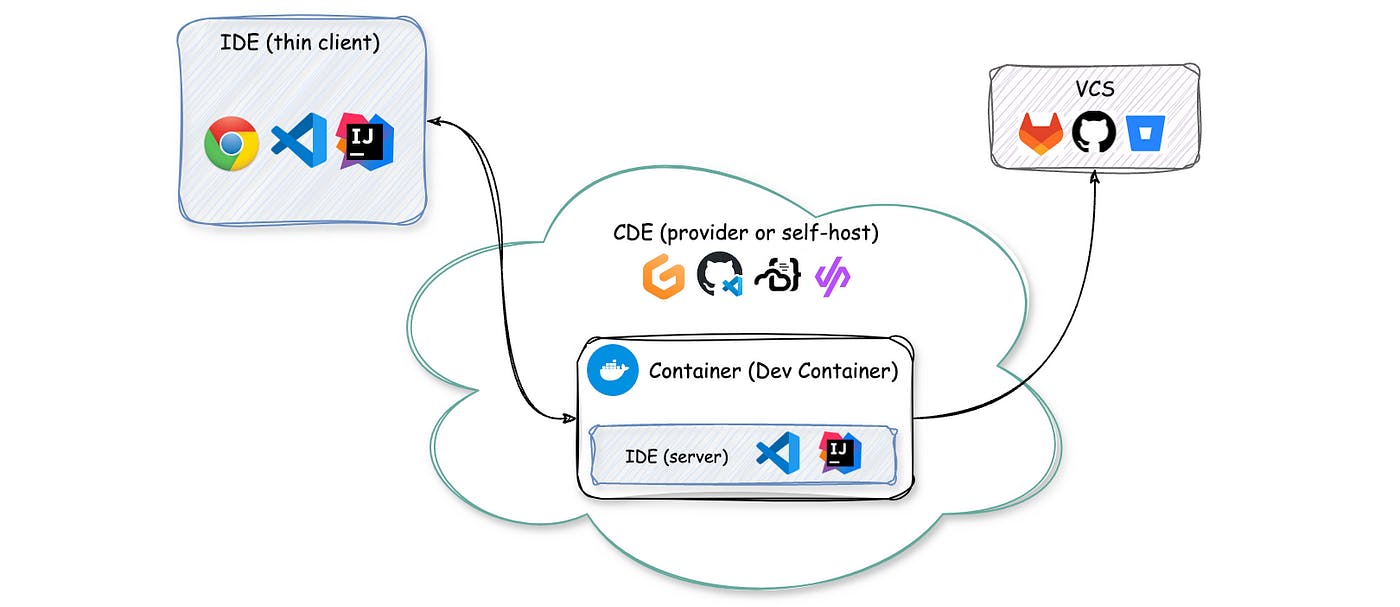Securing the development workflow against data leaks is critical to individuals and teams. Organizations must balance robust security measures while maintaining developer productivity and a seamless developer experience.
Choosing the Right Technology to Safeguard Your Development Workflow Against Data Leaks
Many organizations struggle to maintain a secure application development workflow that prevents data leaks while preserving developers’ productivity. With developers increasingly targeted by hackers, safeguarding source code and credentials is critical.
This article provides a comprehensive comparison of VDI and CDEs across three dimensions: applicability to the development process, security focus, and developer experience. The goal is to help organizations make informed decisions about which technology—or combination of technologies—best suits their needs.
Understanding Virtual Desktops
Virtual Desktops have emerged as a solution to protect the development workflow by centralizing data and desktop applications. Leading providers like Citrix (VDI), Remote Desktop Services and VMware (Horizon) offer Virtual Desktop Infrastructure (VDI) solutions that provide remote access to general-purpose desktops (Windows or Linux). Developers can install Integrated Development Environments (IDEs), DevOps tools (e.g., container management), and access web applications essential for their workflow.

Key Features of Virtual Desktops:
Virtual desktops rely on protocols like Remote Desktop Protocol (RDP) to enable seamless interaction and management. These protocols support key features, including:
Remote Access: Utilizes protocols like RDP to stream desktop images to local devices.
Centralized Control: Maintain sensitive data on secure remote servers, reducing the risk of local data breaches.
Compute Power: Access additional computing resources for building applications without relying on local hardware.
Exploring Cloud Development Environments (CDEs)
Cloud Development Environments (CDEs) represent the next evolution in secure development workflows. These platforms provide online access to development environments with built-in security mechanisms via a web-based IDE. Unlike traditional VDI, CDEs leverage containerization for lightweight virtualization, enhancing scalability and efficiency.

Essential Features of CDEs:
Container-Based Virtualization: Use containers instead of full virtual machines, reducing resource consumption and increasing scalability.
Web-Based IDEs: Access development environments directly through a web browser without needing remote desktop protocols.
Enhanced Security: Implement robust data loss prevention (DLP) measures to protect development data and web application access.
Comparing VDI and CDEs
Applicability to Code Development
Virtual Desktops (VDI):
Use Cases: Ideal for onboarding remote developers, implementing BYOD policies, and scenarios requiring centralized control over development environments.
Development Setup: Developers install and manage their IDEs and tools on the virtual desktop, which serves as the primary compute resource.
Compute Resources: Remote desktops provide dedicated computing power, which can be costly if underutilized.
Cloud Development Environments (CDEs):
Use Cases: Suited for cloud-native, web-based, and mobile application development, offering centralized and standardized environments.
Development Setup: Developers access containerized environments via a web-based IDE, eliminating the need for remote desktop protocols.
Compute Resources: Shared compute infrastructure allows for efficient resource utilization and scalability.
Focus on Security
Virtual Desktops (VDI):
Data Protection: Centralizes data and applications, reducing endpoint vulnerabilities and preventing local data leaks.
DLP Measures: Implements system hardening, user access controls, and data egress restrictions to prevent unauthorized data transfers.
Network Security: Enforces network policies to protect against data exfiltration via internet connectivity.
Cloud Development Environments (CDEs):
Data Protection: Removes local development data by hosting environments in the cloud, minimizing the risk of local data breaches.
Comprehensive DLP: Combines client-side and back-end DLP to secure both development data and access to web applications.
Context-Aware Security: Utilizes the context of application development to enhance security measures, making them productivity enablers rather than hindrances.
Impact and Benefits to Developer Experience
Virtual Desktops (VDI):
Accessibility: Developers interact with remote desktops via RDP, which can suffer from latency issues affecting responsiveness.
Developer Experience: Latency and network dependency can hinder productivity, especially when accessing resource-intensive applications.
Cloud Development Environments (CDEs):
Accessibility: Access development environments directly through a web browser with minimal latency, enhancing the developer experience.
Developer Experience: Native rendering of web-based IDEs ensures a smooth and responsive workflow without the delays associated with streaming protocols.
Advantages of Combining Technologies
While VDI and CDEs each offer distinct advantages, integrating them can provide a balanced approach to security and productivity:
Enhanced Security: Combining CDEs with VDI can leverage the centralized control of VDI with the scalable, secure environments of CDEs.
Optimized Resource Utilization: Use CDEs for development tasks while maintaining VDI for other enterprise applications, reducing overall compute costs.
Improved Developer Experience: Provide developers with responsive, web-based environments through CDEs while maintaining secure access to legacy applications via VDI.
Deciding on Cloud Development Environments (CDEs)
Enhanced Security: Comprehensive data loss prevention measures protect development data and web applications.
Scalability: Container-based virtualization allows for efficient resource utilization and easy scalability.
Developer Productivity: Web-based IDEs provide a seamless and responsive development experience without latency issues.
Cost-Effective: Shared compute infrastructure reduces the costs associated with dedicated virtual desktops.
Ease of Management: Centralized management of development environments simplifies setup and maintenance.
Conclusion
Both Virtual Desktop Infrastructure (VDI) and Cloud Development Environments (CDEs) play crucial roles in securing the application development process. CDEs offer a modern, scalable, and efficient approach to secure development, enhancing the developer experience and reducing costs associated with dedicated compute resources. However, VDI remains a robust solution for centralized control and data protection across various enterprise applications.
Integrating CDEs with VDI can provide a comprehensive security framework that leverages the strengths of both technologies, ensuring data protection, optimizing resource utilization, and maintaining high levels of developer productivity. Ultimately, the choice between VDI and CDEs—or a combination of both—depends on your organization’s specific needs, existing infrastructure, and security requirements.




